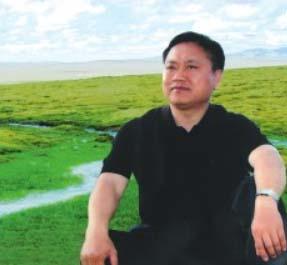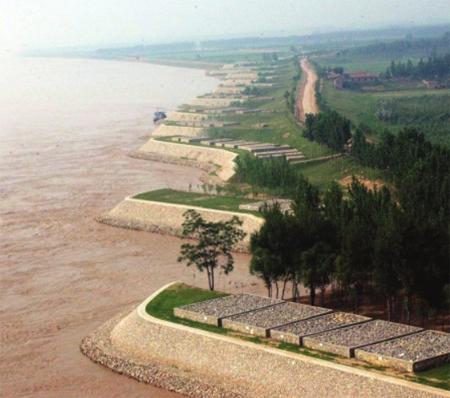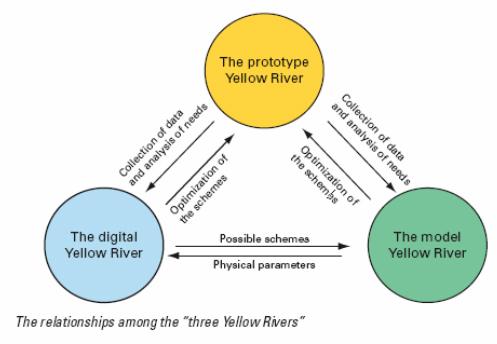|
Li Guoying Li Guoying was born in Yuzhou City, Henan Province, in 1964. He graduated from the North China Institute of Water Conservancy and Hydroelectric Power in 1984 and then began work as an engineer at the Yellow River Conservancy Commission (YRCC). He has been commissioner of the YRCC since May 2001. China has suffered the loss of millions of lives to floods and droughts. Although the last decade saw floods of a similar magnitude,the number of casualties was comparatively low. What measures have been taken to overcome these extreme events? We have adopted an approach to flood management which integrates structural and non-structural measures, balancing human needs with ecological conservation. Through this integrated approach, socio-economic development and effective disaster prevention have been possible. Embankments, reservoirs and flood-retention areas have been established to increase flood control and enable drought management.The structural flood-control system in China is designed basically for a discharge capacity of maximum flood recorded since the 1950s for large rivers and five- to ten-year flood frequency for smaller rivers. Non-structural flood control measures have been optimized, mainly by developing and applying flood-forecasting and warning systems, implementing laws, regulations, policies and economic approaches. These include managing river channels, providing water-retention areas, guiding people who are living in those areas to safer places, and evacuation and rescue during floods. Potential flood risks are being reduced to a level which the society and economy can address and flood prevention schemes have been established against extremely large floods. This approach has strengthened public awareness of disaster-prevention and reduction measures,enhanced disaster-response ability,and has encouraged public involvement in flood control and disaster relief management. It has enabled a human defence system, whereby flood control and disaster relief management are suitable to both society and the economy.
Dyke works in Liangshan county (Photo: Zhang Zaihou) What major shifts have taken place in the flood policies of China in the recent past?
How are the risks due to flood hazards and sustainable development balanced in the Yellow River basin? How are various stakeholders involved in decision-making?
Management and development of the Yellow River must take into account the interests of all regions and sectors. All significant issues are carefully studied and the decisions are made together with local governments and communities.First, the relevant departments jointly formulate a draft plan and comments are requested from various sectors. Only then is the plan finalized and submitted to the appropriate state department for approval. During implementation, various sectors are consulted to further improve it. The Yellow River Conservancy Commission(YRCC), together with the provinces of Shanxi, Shaanxi, Henan and Shandong, have set up a Yellow River flood control and droughtrelief headquarters, which shoulders the responsibility of regulation and management. In view of China s fast growing economy, what special measures are required that fall within the competency of the Yellow River Conservancy Commission? The Yellow River is the lifeblood of the Chinese nation. With the rapid social and economic development in the basin and adjacent regions, problems such as water shortage and water-quality deterioration are encountered. The YRCC adopts measures to support social and economic development through sustainable water use. These include measures for protecting water resources, as well as for water- pollution prevention and treatment. A regulatory system has been developed for each stage of the process, i.e. implementation, feedback and decision-making, which takes into consideration the interactions of the upper and lower reaches, left and right banks, irrigation and power generation, etc. At the same time, the YRCC has enhanced supervision and management. Automatic and remote observations and measurements have brought about improved management at all levels. To solve the conflict between water supply and demand, the YRCC has developed a water-use plan according to a long- and mediumterm supply-and-demand pattern, and currently available water resources. Annual water-use plans are issued to users for balancing demand between cities and among sectors and to ensure an adequate supply for priority areas in case of drought. It has also established practical water-saving regulations, encouraging domestic users to adopt water-saving technologies and devices, appropriate agriculture practices, adjusting industrial structure in the river basin, developing industrial water-saving; and establishing a price system that corresponds to the market economy. From a long-term perspective, integrated Yellow River management will be adopted by enhancing groundwater management and transferring water from south to north.
The downstream channel model of the Yellow River (Photo: Tang Hua) You have been a strong advocate of maintaining the healthy life of the Yellow River . Given development imperatives, how can this be achieved? Ensuring its healthy life is the overall objective of Yellow River management. It has been embodied in the new river management concept, with four-fold objectives: The four objectives can be realized through nine approaches: reducing sediment into the Yellow River;managing water use in the river basin and adjoining regions; diverting water from other river basins to the Yellow River; constructing a water and sediment regulation system; establishing and implementing scientific management schemes for the lower Yellow River channel; forming runoff processes which prevent the main river channel from shrinking; protecting water resources to meet quality demands;managing the estuary to reduce its negative influence on the lower river channel; and keeping the delta ecosystem healthy. In order to implement the above approaches, we have to study and demonstrate the impacts of each detailed scheme in the context of three Yellow Rivers: the Real Yellow River, the Digital Yellow River and the Physical Scaled Model Yellow River. By improving the system of the three Yellow Rivers, we can ensure effective, economic, safe and reliable approaches and technologies. This requires close collaboration between various scientific disciplines and government organizations such as the China Meteorological Administration, and various educational and research institutions. The four objectives, nine approaches and three Yellow Rivers are interrelated and synergized.They constitute the initial theoretical framework of preserving the healthy life of the Yellow River. We believe that, within a few years, an energetic new healthy Yellow River, with constant flow, will emerge and benefit the Chinese nation in an optimal way. Are the present institutional arrangements and mindset adequate to handle the multidisciplinary inputs required to address these issues?How important is the legal and institutional framework for putting plans into practice? The present management mechanism has evolved through long-term development. The YRCC is in charge of, and directly manages,key reaches, while local governments are responsible for regional management. This mechanism plays an important role in ensuring the safety of the Yellow River and promoting social and economic development. A management mechanism must not be rigid. It must evolve with the social environment. In recent years,as the economy has developed,new conflicts and problems have emerged, such as between development and environmental protection;interregional and interdepartmental water use; alleviating disasters and gaining benefits; national and local benefits, etc. In addition, there are a number of regions and multidisciplinary users with an interest in harnessing and developing the Yellow River. It is complicated to coordinate relationships and balance benefits. The challenges in water affairs are more complex, compared with other areas of development. Strengthening the integrated plan,managing the Yellow River basin and coordinating the various uses are issues which need to be urgently addressed. We hope to establish a legal system for managing the Yellow River (Yellow River Law) to improve water-resources management capability within the existing legal framework,taking the special situation of the Yellow River into due consideration. Rights and obligations of the management agencies and their respective responsibilities will be defined through legislation, as well as economic and administrative instruments. It will be beneficial for integrated water-resources management in the whole basin, because it will avoid the segmentation of provincial management and help tackle the problems of flood risk, pollution and soil erosion. The boundless stretch of the rolling and gullied loess plateau (Photo: Yin Hexian) The Yellow River is known for its extraordinary sediment yield. What are its major causes? Could you share with our readers the various measures that the Yellow River Conservancy Commission has planned and implements to tackle this problem? The Yellow River runs through the largest loess plateau in the world.Its loose soil, dry climate, sparse vegetation, steep slopes, violent storms and inappropriate land practices result in severe water and soil erosion. According to the assessment carried out by remote-sensing in 1990, 70.9 per cent of the total loess plateau area (640 000 km2) is prone to water and soil erosion.Moreover, the area affected by severe water erosion is 85 000 km2, which is 64 per cent of the total area of China affected by water erosion. The sediment problem is not only one of too much silt but also of less water, causing disequilibrium between water and sediment. The approach to balancing the water and sediment relationship includes increasing river flows, reducing sediment and balancing water and sediment. One way of increasing river flow is saving water by avoiding flood irrigation. This has limited potential as it is difficult to balance the water and sediment only through saved water. The other way is to supplement flows into the Yellow River by implementing the western route of water transfer from south to north. The Yellow River is like a person: the more water that is used, the more blood will be lost. When loss of blood endangers life, a blood transfusion is necessary. Increasing water is like a blood transfusion for keeping the Yellow River healthy! It is important to reduce the coarse sediment that is deposited mostly in the lower river channel. We have adopted measures to build three lines of defence to prevent this. The first is to trap coarse sediment in the loess plateau by soil conservation works. Warping dams and other relevant vegetative measures focus on the source areas of the sediment. The second line of defence is to store coarse sediment on the Xiaobeiganliu floodplain, while the fine sediment is discharged into the Yellow River. The effectiveness of this measure depends on natural power and the facilities to screen coarse sediment from fine. The third line of defence is to trapping coarse in the Xiaolangdi reservoir and releasing the fine sediment downstream. Generally speaking, water and sediment flow can be regulated by releasing water from reservoirs to create flow conditions which flush sediment deposited in channels and reservoirs out to sea. Trial results from three experiments have shown that it is possible to change the water-sediment relationship to increase erodibility of the riverbed and reduce sediment deposition. Emphasis should be placed on continuous regulation of water and sediment flow in the long term and the joint operation of several reservoirs, including for water transfer from south to north. The density current released with sediments from Xiaolangdi Reservoir (Photo: Zhu Weidong) How do you take into account similar experiences from other river basins and how do you share your experiences with the international community? The Yellow River has its special characteristics but also shares some with other rivers. The YRCC follows the principle of opening to the world and sharing experiences of its development strategies. It actively develops cooperation and exchange with other river basin agencies, water organizations and institutes worldwide. International cooperation and communication activities are carried out in various ways. Hundreds of water experts from other institutions and countries visit the YRCC every year. The YRCC also organizes study tours for water experts and river basin managers to exchange experiences in project development and research. International cooperation programmes aim to keep the Yellow River healthy by combining practical experiences in integrating water and soil erosion, ecosystem conservation, flood control, forecasting and warning, dike reinforcing and water retention management within the IWRM principles. The YRCC has cooperated with a number of development banks. Since 2002, the YRCC has implemented a five-year programme to train professional who have international cooperation skills. Ten water experts are selected every year to study the new concepts of water-resources management abroad. Until now, the YRCC has trained about more than 40 persons. The YRCC participates actively in international water events such as the Stockholm World Water Week, the International Symposium on River Sedimentation, the 4th World Water Forum and the International Congress of International Commission on Irrigation and Drainage. These events provide us with the opportunity to disseminate Yellow River management achievements and learn from others. The YRCC established the Yellow River Forum to exchange experiences and promote cooperation among Chinese experts and those from abroad. The first two forums were held in 2003 and 2005 and the YRCC is currently preparng the third Forum which will be held in October 2007. Flood forecasting and warning has a special role in adopting an integrated approach to flood management. Could you provide some information on the flood forecasting system in China in general and the Yellow River basin in particular? The Hydrological Bureau of the Ministry of Water Resources has developed a national flood fore-casting system for the main rivers of China. The economic and social benefits of flood forecasting in China are remarkable. Direct economic benefit amounts to tens of billions RMB each year. In 1998, the direct benefit through disaster reduction was above 80 billion RMB. The main flood forecasting methods adopted in China use rainfall and runoff models and flood-routeing models. Distributed hydrological models have been tested for research in some small river basins, but have not yet been put into practice. Rainfed floods in the Yellow River Basin are characterized by uneven temporal and spatial distribution of precipitation, high sediment content of the floodwaters and abrupt rise and fall of the waters. In the upper Yellow River, Xiaobeiganliu, the Weihe River and the lower Yellow River, flood-routeing methods have been adopted for flood forecasting. In the Sanmenxia-Huayuankou reach, a rainfall-runoff forecasting method is adopted. There are three stages: pre-warning forecasting (with forecast precipitation as input to the forecasting model), referencing forecasting (with observed precipitation as model input) and formal forecasting (with discharge as model input). The China Meteorological Administration provides important inputs at all three stages of forecasting through quantitative precipitation forecasts which are issued regularly through its national weather forecasts and warnings and short-range climate predictions. There are 168 Yellow River hydrological forecasting pre-schemes in total, some of which have been omputerized. There are 34 rainfallrunoff models and flood-routeing models. Due to the complexity of the flooding and the influence of human activities, there are difficulties in applying many of the forecasting methods. The YRCC is exploring the use of advanced methods of information collection and flood-forecasting models to carry out flood forecasting and to provide better scientific and technological support to the integrated river basin management. A distributed hydrological forecasting system of the Xiaolangdi-Huayuankou Rainstorm Flood Pre-warning and Forecasting System a component of the Digital Yellow River Project is being constructed and will be put into use in the coming flood season. Do you have a message for the readers of the WMO Bulletin? In recent years, the YRCC has carried out in-depth research on Yellow River water-resources management strategies, identified a new management concept for keeping the river healthy, ensured flood security and built a quick response mechanism for severe water-pollution events. Remarkable achievements have also been obtained in the construction of flood-control projects. We have made advances in the prevention of water and soil erosion, significantly improved the level of science, technology and modernization in river management and have made significant progress in various aspects of Yellow River management. The WMO Bulletin is an excellent mechanism for exchanging information and is widely distributed among the international meteorological and hydrological communities. I take this opportunity to sincerely invite experts and friends worldwide to learn about the Yellow River. I encourage them to visit the YRCC for an exchange of experience and cooperation and we also welcome suggestions. We believe that the Yellow River belongs not only to China, but to the world. |
Source: yellowriver.gov.cn Editor: huangfeng








